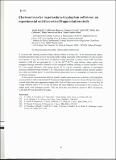Por favor, use este identificador para citar o enlazar a este item:
http://hdl.handle.net/10261/135460COMPARTIR / EXPORTAR:
 SHARE
BASE SHARE
BASE
|
|
| Visualizar otros formatos: MARC | Dublin Core | RDF | ORE | MODS | METS | DIDL | DATACITE | |

| Título: | Electron transfer in potassium-tryptophan collisions: an experimental and theoretical fragmentation study |
Autor: | Rebelo, A.; Meneses, G.; García, Gustavo CSIC ORCID; Gil, A.; Calhorda, Maria José; Ferreira da Silva, F.; Limão-Vieira, P. | Fecha de publicación: | 17-jul-2015 | Citación: | XIX International Symposium on Electron-Molecule Collisions and Swarms (2015) XVIII International Workshop on Low-Energy Positron and Positronium Physics (2015) |
Resumen: | It is known that ionizing radiation bring adverse effects to living cells. In the femtosecond regime, multiple ionizations may occur in the human body leading ultimately to the formation of radical and/or ionic species. In fact, for every MeV of radiation energy deposited in matter, about 5x10! secondary electrons (<100 eV) are generated [1, 2]. In the 10!!>-10!!>s time window, these entities may propagate through nanometer distances in the biological medium, leading to several inelastic events [3]. Low energy electrons, with energy below 20 eV can be resonantly captured in unoccupied molecular orbitals (virtual orbitals) [4, 5]. This process results in an unstable excited transient negative ion, which can further decay via auto detachment, dissociation or, in a comparatively long time scale, via photon emission. In the present communication electron transfer studies upon potassium collisions with tryptophan, are presented as well as theoretical DFT analysis. Experimental results have been obtained by means a crossed molecular beam apparatus coupled with Time-of-Flight mass spectrometer. It is clear that for energy collision below 75 eV in the lab frame, the main fragment corresponds to the scission of Cß indole bond, with hydrogen transfer. This has been also described by means to DFT calculations, CAM-B3LYP and BHandHLYP codes | Descripción: | POSMOL 2015, 17-20 July 2015, Lisboa, Portugal; http://eventos.fct.unl.pt/posmol2015/ | URI: | http://hdl.handle.net/10261/135460 |
| Aparece en las colecciones: | (CFMAC-IFF) Comunicaciones congresos |
Ficheros en este ítem:
| Fichero | Descripción | Tamaño | Formato | |
|---|---|---|---|---|
| Electron0003.pdf | 590,75 kB | Adobe PDF |  Visualizar/Abrir |
CORE Recommender
Page view(s)
138
checked on 23-abr-2024
Download(s)
79
checked on 23-abr-2024
Google ScholarTM
Check
NOTA: Los ítems de Digital.CSIC están protegidos por copyright, con todos los derechos reservados, a menos que se indique lo contrario.
